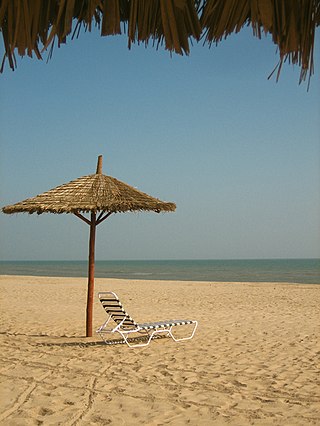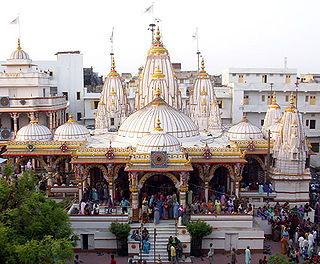Related Research Articles
The Memon are a Muslim community in Gujarat India, and Sindh, Pakistan, the majority of whom follow the Hanafi fiqh of Sunni Islam. They are divided into different groups based on their origins: Kathiawari Memons, Kutchi Memons and Bantva Memons from the Kathiawar, Kutch and Bantva regions of Gujarat respectively, and Sindhi Memons from Sindh.

Kutchi or Kachhi is an Indo-Aryan language spoken in the Kutch region of India and Sindh region of Pakistan.

Vasai is a historical place and city located in Palghar district; which was partitioned out of the Thana district in 2014. It also forms a part of Vasai-Virar twin cities in the Konkan division, Maharashtra, India, and comes under the Police Jurisdiction of Mira-Bhayander, Vasai-Virar Police Commissionerate.

Bhuj is a city and the headquarters of Kutch district in the Indian state of Gujarat.

Mandvi is a beach town with municipality in the Kachchh district (Kutch) in the Indian state of Gujarat. It was once a major port of the region and summer retreat for Maharao (king) of the Cutch State. The old city was enclosed in the fort wall and remains of the fort wall can still be seen. The city has a four-hundred-year-old ship building industry which is still functional and dhows, a type of wooden ship, are still made. Mandvi Municipality's 36 Seat Of 9 Ward.

The Shikshapatri is a religious text consisting of two hundred and twelve verses, written in Sanskrit by Swaminarayan. The Shikhapatri is believed to have been written in the current form in Sanskrit by Sahajanand Swami, who incorporated into and compiled the scripture known as Satsangi Jivan. The Shikshapatri is a key scripture to all followers of the Swaminarayan Sampradaya and is considered the basis of the sect.

Elphinstone College is one of the constituent colleges of Dr. Homi Bhabha State University, a state cluster university. Established in 1823, it is one of the oldest colleges in Mumbai. It played a major role in shaping and developing the educational landscape of the city. It also played a pivotal role in the inception of the University of Mumbai.

Swaminarayan, also known as Sahajanand Swami, was a yogi and ascetic believed by followers to be a manifestation of Krishna or the highest manifestation of Purushottama, around whom the Swaminarayan Sampradaya developed.
The Laksmi Narayan Dev Gadi is one of the two gadis (diocese) that together form the Swaminarayan Sampradaya. It is headquartered at the Shri Swaminarayan Mandir, Vadtal and controls the Dakshin Vibhag Lekh.
Botad is a city and district headquarters of Botad district, Gujarat, India. It is about 92 km from Bhavnagar and 133 km From Ahmedabad by road distance.

Shri Swaminarayan Mandir, Mumbai is a Hindu temple (Mandir) and a part of the Swaminarayan Sampraday. This Swaminarayan Temple is located in the Bhuleshwar area of Mumbai and is the oldest Swaminarayan Mandir in Mumbai, being over a hundred years old.

Shree Swaminarayan Mandir Kalupur is the first Temple of the Swaminarayan Sampraday, a Hindu sect. It is located in Kalupur area of Ahmedabad, the largest city in Gujarat, India. It was built on the instructions of Swaminarayan, the founder of the sect.

Swaminarayan Mandir, Vadtal headquarters of the LaxmiNarayan Dev Gadi are located in this temple in Vadtal. There are three main shrines in the temple the central shirne of this temple is that of Lakshmi Narayan and RanchodRai. On the right there is idol of Radha Krishna with Swaminarayan in the form of Hari Krishna and the left has Vasudev, Dharma and Bhakti. The wooden pillars of the temple bear colourful wood carvings. There is a dharamsala within the temple premises. Gnyanbaug is a garden to the northwest of the temple gate that has four memorials dedicated to Swaminarayan.

Rao Bahadur Govind Sakharam Sardesai, popularly known as Riyasatkar Sardesai, was a historian from Bombay Presidency, India.
Rao Bahadur Gopal Hari Deshmukh also known as Lokhitwadi was an Indian activist, thinker, social reformer and writer from Maharashtra. His original surname was Shidhaye. Because of 'Vatan' that the family had received, the family was later called Deshmukh. Deshmukh is regarded as an important figure of the Social Reform Movement in Maharashtra.

Acharya Shree Tejendraprasadji Maharaj founded International Swaminarayan Satsang Organization (I.S.S.O.) in the United States on the occasion of Vijaya Dashami in the year 1978.

Chhaganlal Karamshi Parekh popularly known as Chhagan Bapa was an Indian philanthropist and social worker who worked for education, the end of poverty, and social reform of women.

Mahagujarat movement, known locally as Mahagujarat Andolan, was a political movement demanding the creation of the state of Gujarat for Gujarati-speaking people from the bilingual Bombay state of India in 1956. It succeeded in the formation of Gujarat on 1 May 1960.

Gujarat Arts & Science College, popularly and previously known as Gujarat College, is one of the oldest educational institutions of India and the second arts and science college of Gujarat, near Ellis Bridge, Ahmedabad. It was founded in 1845 as a government-run educational institute, was established as a regular college in 1850, and is now under the direct management of the Education Department of the Government of Gujarat.
References
- ↑ The Bombay university calendar, Volume 2. University of Bombay. 1925. p. 642.
- ↑ "Rao Bahadur Sheth Curumsey Damjee (1844-1918)". Archived from the original on 8 February 2013. Retrieved 5 April 2013.
- ↑ Mahadev Haribhai Desai; Narahari Dvārakādāsa Parīkha; Hemantkumar Gunabhai Nilkanth (1968). Day-to-day with Gandhi. Sarva Seva Sangh Prakashan. Retrieved 27 March 2009. Page 205
- 1 2 3 "About Rao Bahadur Sheth Curumsey Damjee". Archived from the original on 16 May 2008.
- ↑ Sorabji M. Rutnagur (1927). Bombay industries. Indian textile journal. Retrieved 27 March 2009. Page 604
- ↑ Roper Lethbridge (1900). The golden book of India: a genealogical and biographical dictionary of the ruling princes, chiefs, nobles, and other personages, titled or decorated, of the Indian empire. Macmillan. Retrieved 27 March 2009. Page 132
- ↑ James Fuller Blumhardt (1915). Catalogue of Marathi and Gujarati printed books in the library of the British museum. B. Quaritch. Retrieved 27 March 2009. Page 112
- ↑ University of Bombay (1930). Bombay university handbook. University of Bombay. Retrieved 27 March 2009. Page 333